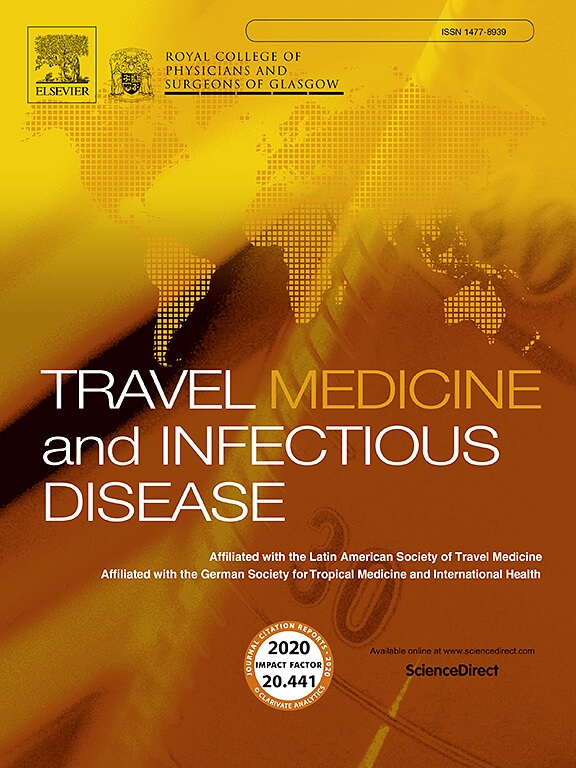Vaccine uptake and adherence to non-pharmaceutical interventions at a youth mass gathering event: A longitudinal field cohort study
IF 4.7
3区 医学
Q1 INFECTIOUS DISEASES
引用次数: 0
Abstract
Background
Youth mass gathering events attract thousands of travellers and produce high-exposure conditions for respiratory pathogens and other communicable diseases. Adolescents and young adults have high social circulation and show higher infection rates for viral threats like SARS-CoV2 than other age groups. How young people self-manage their elevated communicable disease risk in high-exposure travel settings such as mass events is under-researched. This study examined vaccination rates, attitudes, and adherence to non-pharmaceutical interventions (e.g., mask-wearing, physical distancing) at a youth mass event during the global COVID-19 pandemic (Oct–Dec 2021).
Methods
Longitudinal cohort design with online surveys 1 month pre- (T0), during (T1-T3) and 1 month post- (T4) event. Participants were N = 291 Australian school-leavers (16–19 years) during end-of-school mass celebrations called ‘Schoolies’. Participants reported travel origin and whether they attended an official Schoolies festival (primary site), or elsewhere (secondary sites). Surveys measured COVID-19 vaccine uptake, vaccine-related attitudes, and adherence to non-pharmaceutical interventions.
Results
At T0, 88% were vaccinated. Pro-vaccine attitudes were a strong positive correlate of vaccination. Primary site (versus secondary site) attendees held more favourable attitudes toward COVID-19 vaccination, perceiving higher vaccine safety, effectiveness, and importance, and lower risk. Vaccine uptake at T0 was associated with poorer subsequent physical distancing. Adherence to non-pharmaceutical interventions declined during the event; but ‘rebounded’ post-event corresponding with Australia's first omicron wave.
Conclusions
Findings provide the first longitudinal picture of non-mandated COVID-19 vaccination rates and adherence to non-pharmaceutical interventions at a youth mass event, with insights for prospective management of health risks after travel vaccinations.
青少年大规模集会事件中的疫苗接种和非药物干预依从性:一项纵向现场队列研究
青年大规模聚会活动吸引了成千上万的游客,并为呼吸道病原体和其他传染病创造了高暴露条件。青少年和青壮年具有较高的社会流通量,对SARS-CoV2等病毒威胁的感染率高于其他年龄组。年轻人在诸如大规模活动等高暴露旅行环境中如何自我管理其较高的传染病风险尚未得到充分研究。本研究调查了全球COVID-19大流行期间(2021年10月至12月)青年群众活动中的疫苗接种率、态度和对非药物干预措施(如戴口罩、保持身体距离)的依从性。方法采用纵向队列设计,在(T0)前1个月、(T1-T3)期间和(T4)后1个月进行在线调查。参与者是291名16-19岁的澳大利亚毕业生,他们参加了名为“学校”的期末集体庆祝活动。参与者报告了旅行来源以及他们是否参加了官方的学校节日(主要地点)或其他地方(次要地点)。调查测量了COVID-19疫苗接种情况、疫苗相关态度以及对非药物干预措施的依从性。结果2010年,88%的人接种了疫苗。支持接种疫苗的态度与接种疫苗有很强的正相关。主站点(与次要站点相比)与会者对COVID-19疫苗接种持更有利的态度,认为疫苗的安全性、有效性和重要性更高,风险更低。0岁时接种疫苗与随后较差的身体距离有关。活动期间,非药物干预措施的依从性有所下降;但在事件发生后,与澳大利亚的第一个欧米波相对应的是“反弹”。研究结果首次提供了青年群众活动中非强制性COVID-19疫苗接种率和非药物干预依从性的纵向图像,并为旅行疫苗接种后健康风险的前瞻性管理提供了见解。
本文章由计算机程序翻译,如有差异,请以英文原文为准。
求助全文
约1分钟内获得全文
求助全文
来源期刊

Travel Medicine and Infectious Disease
PUBLIC, ENVIRONMENTAL & OCCUPATIONAL HEALTH-INFECTIOUS DISEASES
CiteScore
19.40
自引率
1.70%
发文量
211
审稿时长
49 days
期刊介绍:
Travel Medicine and Infectious Disease
Publication Scope:
Publishes original papers, reviews, and consensus papers
Primary theme: infectious disease in the context of travel medicine
Focus Areas:
Epidemiology and surveillance of travel-related illness
Prevention and treatment of travel-associated infections
Malaria prevention and treatment
Travellers' diarrhoea
Infections associated with mass gatherings
Migration-related infections
Vaccines and vaccine-preventable disease
Global policy/regulations for disease prevention and control
Practical clinical issues for travel and tropical medicine practitioners
Coverage:
Addresses areas of controversy and debate in travel medicine
Aims to inform guidelines and policy pertinent to travel medicine and the prevention of infectious disease
Publication Features:
Offers a fast peer-review process
Provides early online publication of accepted manuscripts
Aims to publish cutting-edge papers
 求助内容:
求助内容: 应助结果提醒方式:
应助结果提醒方式:


